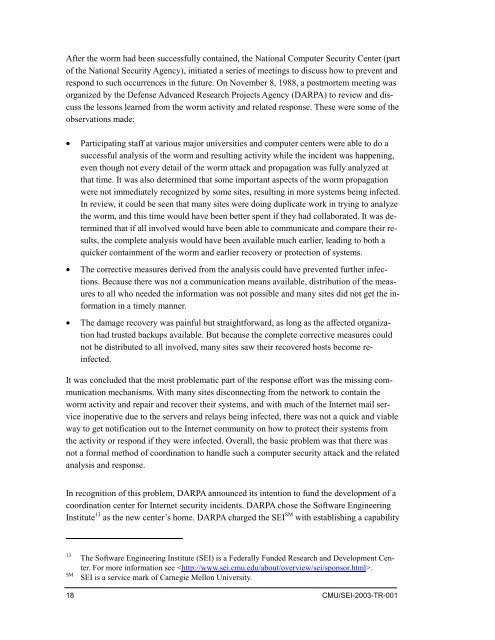State of the Practice of Computer Security Incident Response Teams ...
State of the Practice of Computer Security Incident Response Teams ...
State of the Practice of Computer Security Incident Response Teams ...
You also want an ePaper? Increase the reach of your titles
YUMPU automatically turns print PDFs into web optimized ePapers that Google loves.
After <strong>the</strong> worm had been successfully contained, <strong>the</strong> National <strong>Computer</strong> <strong>Security</strong> Center (part<br />
<strong>of</strong> <strong>the</strong> National <strong>Security</strong> Agency), initiated a series <strong>of</strong> meetings to discuss how to prevent and<br />
respond to such occurrences in <strong>the</strong> future. On November 8, 1988, a postmortem meeting was<br />
organized by <strong>the</strong> Defense Advanced Research Projects Agency (DARPA) to review and discuss<br />
<strong>the</strong> lessons learned from <strong>the</strong> worm activity and related response. These were some <strong>of</strong> <strong>the</strong><br />
observations made:<br />
• Participating staff at various major universities and computer centers were able to do a<br />
successful analysis <strong>of</strong> <strong>the</strong> worm and resulting activity while <strong>the</strong> incident was happening,<br />
even though not every detail <strong>of</strong> <strong>the</strong> worm attack and propagation was fully analyzed at<br />
that time. It was also determined that some important aspects <strong>of</strong> <strong>the</strong> worm propagation<br />
were not immediately recognized by some sites, resulting in more systems being infected.<br />
In review, it could be seen that many sites were doing duplicate work in trying to analyze<br />
<strong>the</strong> worm, and this time would have been better spent if <strong>the</strong>y had collaborated. It was determined<br />
that if all involved would have been able to communicate and compare <strong>the</strong>ir results,<br />
<strong>the</strong> complete analysis would have been available much earlier, leading to both a<br />
quicker containment <strong>of</strong> <strong>the</strong> worm and earlier recovery or protection <strong>of</strong> systems.<br />
• The corrective measures derived from <strong>the</strong> analysis could have prevented fur<strong>the</strong>r infections.<br />
Because <strong>the</strong>re was not a communication means available, distribution <strong>of</strong> <strong>the</strong> measures<br />
to all who needed <strong>the</strong> information was not possible and many sites did not get <strong>the</strong> information<br />
in a timely manner.<br />
• The damage recovery was painful but straightforward, as long as <strong>the</strong> affected organization<br />
had trusted backups available. But because <strong>the</strong> complete corrective measures could<br />
not be distributed to all involved, many sites saw <strong>the</strong>ir recovered hosts become reinfected.<br />
It was concluded that <strong>the</strong> most problematic part <strong>of</strong> <strong>the</strong> response effort was <strong>the</strong> missing communication<br />
mechanisms. With many sites disconnecting from <strong>the</strong> network to contain <strong>the</strong><br />
worm activity and repair and recover <strong>the</strong>ir systems, and with much <strong>of</strong> <strong>the</strong> Internet mail service<br />
inoperative due to <strong>the</strong> servers and relays being infected, <strong>the</strong>re was not a quick and viable<br />
way to get notification out to <strong>the</strong> Internet community on how to protect <strong>the</strong>ir systems from<br />
<strong>the</strong> activity or respond if <strong>the</strong>y were infected. Overall, <strong>the</strong> basic problem was that <strong>the</strong>re was<br />
not a formal method <strong>of</strong> coordination to handle such a computer security attack and <strong>the</strong> related<br />
analysis and response.<br />
In recognition <strong>of</strong> this problem, DARPA announced its intention to fund <strong>the</strong> development <strong>of</strong> a<br />
coordination center for Internet security incidents. DARPA chose <strong>the</strong> S<strong>of</strong>tware Engineering<br />
Institute 13 as <strong>the</strong> new center’s home. DARPA charged <strong>the</strong> SEI SM with establishing a capability<br />
13<br />
SM<br />
The S<strong>of</strong>tware Engineering Institute (SEI) is a Federally Funded Research and Development Center.<br />
For more information see .<br />
SEI is a service mark <strong>of</strong> Carnegie Mellon University.<br />
18 CMU/SEI-2003-TR-001
















